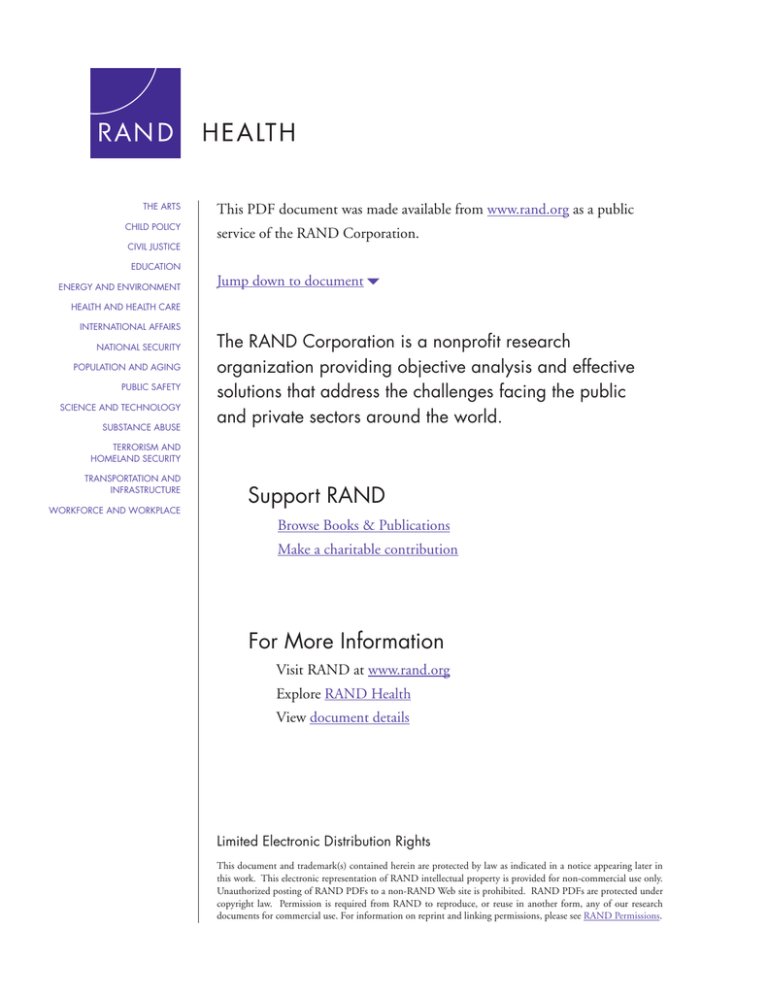6 om as a public service of the RAND Corporation.
advertisement

THE ARTS CHILD POLICY CIVIL JUSTICE EDUCATION ENERGY AND ENVIRONMENT This PDF document was made available from www.rand.org as a public service of the RAND Corporation. Jump down to document6 HEALTH AND HEALTH CARE INTERNATIONAL AFFAIRS NATIONAL SECURITY POPULATION AND AGING PUBLIC SAFETY SCIENCE AND TECHNOLOGY SUBSTANCE ABUSE The RAND Corporation is a nonprofit research organization providing objective analysis and effective solutions that address the challenges facing the public and private sectors around the world. TERRORISM AND HOMELAND SECURITY TRANSPORTATION AND INFRASTRUCTURE WORKFORCE AND WORKPLACE Support RAND Browse Books & Publications Make a charitable contribution For More Information Visit RAND at www.rand.org Explore RAND Health View document details Limited Electronic Distribution Rights This document and trademark(s) contained herein are protected by law as indicated in a notice appearing later in this work. This electronic representation of RAND intellectual property is provided for non-commercial use only. Unauthorized posting of RAND PDFs to a non-RAND Web site is prohibited. RAND PDFs are protected under copyright law. Permission is required from RAND to reproduce, or reuse in another form, any of our research documents for commercial use. For information on reprint and linking permissions, please see RAND Permissions. This product is part of the RAND Corporation technical report series. Reports may include research findings on a specific topic that is limited in scope; present discussions of the methodology employed in research; provide literature reviews, survey instruments, modeling exercises, guidelines for practitioners and research professionals, and supporting documentation; or deliver preliminary findings. All RAND reports undergo rigorous peer review to ensure that they meet high standards for research quality and objectivity. California Ambulatory Surgery Centers A Comparative Statistical and Regulatory Description William B. Vogt, John A. Romley Sponsored by the California HealthCare Foundation HEALTH This work was sponsored by the California HealthCare Foundation. The research was conducted in RAND Health, a division of the RAND Corporation. The RAND Corporation is a nonprofit research organization providing objective analysis and effective solutions that address the challenges facing the public and private sectors around the world. RAND’s publications do not necessarily reflect the opinions of its research clients and sponsors. R® is a registered trademark. © Copyright 2009 RAND Corporation Permission is given to duplicate this document for personal use only, as long as it is unaltered and complete. Copies may not be duplicated for commercial purposes. Unauthorized posting of R AND documents to a non-R AND Web site is prohibited. R AND documents are protected under copyright law. For information on reprint and linking permissions, please visit the RAND permissions page (http://www.rand.org/publications/ permissions.html). Published 2009 by the RAND Corporation 1776 Main Street, P.O. Box 2138, Santa Monica, CA 90407-2138 1200 South Hayes Street, Arlington, VA 22202-5050 4570 Fifth Avenue, Suite 600, Pittsburgh, PA 15213-2665 RAND URL: http://www.rand.org To order RAND documents or to obtain additional information, contact Distribution Services: Telephone: (310) 451-7002; Fax: (310) 451-6915; Email: order@rand.org - ix - SUMMARY Over the last 20 years, there has been enormous growth in the number of ambulatory surgery centers (ASCs), nationally and in California. With this growth has come an increased interest in ASCs in the scholarly, legislative, and policy communities. Most ASCs are for- profit; many ASCs are physician-owned; and ASCs compete directly with hospitals in the provision of profitable outpatient surgery services. Furthermore, little is known about ASC quality measurement, and there has been little work systematically measuring either the ways in which ASCs are currently regulated or the ways such regulations affect costs, quality, and other outcomes of interest. Regulatory issues are particularly salient for California at present. California has a unique two-track process for regulating ASCs. Physician-owned ASCs are regulated by the Medical Board as “outpatient settings,” whereas other ASCs are regulated by the Department of Public Health (DPH) as “surgical clinics.” Recently, the California legislature has been considering changes to this regulatory framework. This report describes the current state of ASCs in California, compares the patients in ASCs and hospital outpatient departments, compares the various categories of ASCs, and compares the regulatory environment in California to that in other states and to the regulatory regime for Medicare-participating ASCs. The report draws on several data sources. Financial, ownership, location, volume of services, and capital expenditures for all DPHregulated ASCs are reported to California’s Office of Statewide Health Planning and Development (OSHPD), which organizes this information into the Primary Care and Specialty Clinics Annual Utilization Dataset. Patient encounter data for all DPH-regulated ASCs and all hospital outpatient surgery departments are also reported to OSHPD and collected in the Emergency Department and Ambulatory Surgery Dataset. Both datasets were acquired from OSHPD for 2005 and 2006. For the regulatory comparison, RAND retained Stateside Associates, a regulatory consulting firm, to collate and summarize ASC regulatory - x - requirements for 15 large U.S. states and for the Medicare program. Stateside abstracted statutes and regulation and interviewed responsible officials. Data on state regulation of ASCs related to licensure, inspection, independent accreditation, quality improvement programs, and data and quality reporting were collected. The 473 California ASCs that report encounter data account for about 1.1 million outpatient surgery encounters, while the 360 California hospitals reporting ambulatory surgery data account for about 1.7 million encounters. Compared to hospital outpatient surgery departments, ASCs perform a lower overall volume of surgeries and are more focused on a few types of procedures. ASCs generally achieve higher volume on those procedures in which they specialize. In general, ASCs tend to serve a higher-income and more-generously-insured population. On one recognized quality indicator, transfer to a hospital, ASCs appear to score slightly worse than do hospital outpatient departments, although performance on this measure improved markedly between 2005 and 2006. However, given the immaturity of the ASC quality measurement literature and the lack of controls for patient risk factors in the work reported here, this finding should be treated with great caution. This finding does point to the need for more research to determine whether the higher transfer rate in ASCs represents a difference in quality. ASCs perform proportionately more cosmetic procedures than do hospitals, and 44 OSHPD-reporting California ASCs specialize in cosmetic procedures. These cosmetic-specializing ASCs serve a younger, more- female, and slightly higher-income patient base than do non-cosmeticspecializing ASCs. Furthermore, patients at cosmetic-specializing ASCs are much more likely to be paying for their procedures out of pocket. On the regulatory front, all 15 states surveyed require inspection for licensure, but the frequency of that inspection varies. Under the “outpatient settings” track of California’s two-track regulation, preannouncement of inspections is required; under the “surgical clinics” track in California and in all other states, there is no such requirement. Licensing/approval is unrelated to accreditation by an agency such as The Joint Commission for the Accreditation of Healthcare - xi - Organizations (JCAHO) under the “surgical clinics” track in California and in five other states. Accreditation satisfies all requirements under the “outpatient settings” track in California and in North Carolina. In the remaining states, accreditation either facilitates licensure, or it is required. Quality regulation was also compared. Most surveyed states and Medicare require ASCs to implement quality assessment and improvement programs; California does not. Most surveyed states require ASCs to report various quality indicators (deaths, transfers to hospitals, wrong-site surgeries, etc) to regulators, while California does not. Most states do not require the reporting of encounter data to regulatory authorities. For those licensed by the DPH, California does. There are a number of avenues for further research regarding public policy for ambulatory surgery centers. First, the research revealed differences in patterns of volume and procedure specialization between ASCs and hospital outpatient surgery departments. These differences could have implications for quality if high volume is associated with quality or if more specialization is associated with higher quality. There is little research on these questions for outpatient surgery at present. Given the heterogeneity in states’ strategies for regulating ASCs and given that ASC quality measures are currently under development, research into the effects of different regulatory strategies on ASC quality would be promising. Finally, given the differences we document in the income and insurance status of hospital and ASC patients, it would be interesting to analyze how the geographical distribution of ASCs and hospital outpatient departments vary and how this affects their respective patient populations. In addition, it would be valuable to analyze competition among ASCs and hospital outpatient departments and how this competition affects the distribution of patients among facilities.





